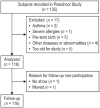The roles of sleep and eating patterns in adiposity gain among preschool-aged children
- PMID: 35833269
- PMCID: PMC9630867
- DOI: 10.1093/ajcn/nqac197
The roles of sleep and eating patterns in adiposity gain among preschool-aged children
Abstract
Background: Short sleep durations are related to risks for obesity in preschool children. However, the underlying mechanism or mechanisms are not clear.
Objectives: We evaluated the relationships between sleep characteristics and body composition, energetics, and weight-regulating behaviors in preschool-aged children, as well as the longitudinal associations between children's sleep and eating patterns and body composition at a 1-year follow-up.
Methods: Data were drawn from a longitudinal study of 118 children aged 3-5 years. Sleep (duration, midpoint, regularity) and physical activity (PA) were measured by accelerometry over 6 consecutive days; total energy expenditure (TEE) was measured using the doubly labeled water method; body composition (fat mass, fat-free mass, and percent body fat) was measured by DXA; and dietary intake (energy intake, timing) was measured using two 24-hour recalls. Multivariable regression was used to estimate interindividual associations of sleep parameters with body composition, PA, TEE, and dietary outcomes and to examine the relationships between sleep and dietary behaviors and body composition 1 year later.
Results: Cross-sectionally, later sleep midpoint is associated with having a greater fat mass (0.33; 95% CI: 0.05, 0.60) and a higher percent body fat (0.92; 95% CI: 0.15, 1.70). Later sleep midpoint was associated with delayed morning mealtimes (0.51; 95% CI: 0.28, 0.74) and evening mealtimes (0.41; 95% CI: 0.29, 0.53), higher nighttime energy intakes (45.6; 95% CI: 19.7, 71.4), and lower morning energy intakes (-44.8; 95% CI: -72.0, -17.6). Longitudinally, shorter sleep duration (-0.02; 95% CI: -0.03, 0.00) and later meal timing (0.83; 95% CI: 0.24, 1.42) were associated with higher percent body fat measurements 1 year later.
Conclusions: Shorter sleep duration and later meal timing are associated with adiposity gains in preschoolers.
Keywords: dietary behaviors; energy expenditure; obesity; physical activity; sleep.
Copyright © 2022 American Society for Nutrition.
Figures
Similar articles
-
Role of physical activity and sleep duration in growth and body composition of preschool-aged children.Obesity (Silver Spring). 2016 Jun;24(6):1328-35. doi: 10.1002/oby.21489. Epub 2016 Apr 18. Obesity (Silver Spring). 2016. PMID: 27087679 Free PMC article.
-
Later Meal and Sleep Timing Predicts Higher Percent Body Fat.Nutrients. 2020 Dec 29;13(1):73. doi: 10.3390/nu13010073. Nutrients. 2020. PMID: 33383648 Free PMC article.
-
Sleep, energy balance, and meal timing in school-aged children.Sleep Med. 2019 Aug;60:139-144. doi: 10.1016/j.sleep.2019.02.003. Epub 2019 Feb 16. Sleep Med. 2019. PMID: 30905623 Free PMC article.
-
Chronotype Differences in Body Composition, Dietary Intake and Eating Behavior Outcomes: A Scoping Systematic Review.Adv Nutr. 2022 Dec 22;13(6):2357-2405. doi: 10.1093/advances/nmac093. Adv Nutr. 2022. PMID: 36041181 Free PMC article.
-
[Simple obesity in children. A study on the role of nutritional factors].Med Wieku Rozwoj. 2006 Jan-Mar;10(1):3-191. Med Wieku Rozwoj. 2006. PMID: 16733288 Review. Polish.
Cited by
-
A tendency toward evening chronotype associates with less healthy diet among preschoolers: cross-sectional findings from the DAGIS study.Sleep Adv. 2024 Apr 20;5(1):zpae026. doi: 10.1093/sleepadvances/zpae026. eCollection 2024. Sleep Adv. 2024. PMID: 38737796 Free PMC article.
-
The Effect of Prebedtime Behaviors on Sleep Duration and Quality in Children: Protocol for a Randomized Crossover Trial.JMIR Res Protoc. 2024 Aug 20;13:e63692. doi: 10.2196/63692. JMIR Res Protoc. 2024. PMID: 39163119 Free PMC article.
-
Associations between Meal Patterns and Risk of Overweight/Obesity in Children and Adolescents in Western Countries: A Systematic Review of Longitudinal Studies and Randomised Controlled Trials.Children (Basel). 2024 Sep 7;11(9):1100. doi: 10.3390/children11091100. Children (Basel). 2024. PMID: 39334632 Free PMC article. Review.
-
Association between serum folate and sleep duration in American adults: A cross-sectional analysis of the National Health and Nutrition Examination Survey 2005 to 2010.Medicine (Baltimore). 2024 Nov 29;103(48):e40767. doi: 10.1097/MD.0000000000040767. Medicine (Baltimore). 2024. PMID: 39612384 Free PMC article.
-
Investigating preschool-aged chronotype and social jetlag as predictors of early adolescent diet and BMI z-score: an eight-year follow-up from the DAGIS study.Int J Obes (Lond). 2025 May;49(5):793-800. doi: 10.1038/s41366-024-01702-4. Epub 2024 Dec 19. Int J Obes (Lond). 2025. PMID: 39702528 Free PMC article.
References
-
- Fatima Y, Doi S, Mamun A. Longitudinal impact of sleep on overweight and obesity in children and adolescents: a systematic review and bias-adjusted meta-analysis. Obes Rev. 2015;16(2):137–49. - PubMed
-
- Miller MA, Kruisbrink M, Wallace J, Ji C, Cappuccio FP. Sleep duration and incidence of obesity in infants, children, and adolescents: a systematic review and meta-analysis of prospective studies. Sleep. 2018;41(4):zsy018. - PubMed
-
- Galland BC, Taylor BJ, Elder DE, Herbison P. Normal sleep patterns in infants and children: a systematic review of observational studies. Sleep Med Rev. 2012;16(3):213–22. - PubMed
-
- Thorpe K, Staton S, Sawyer E, Pattinson C, Haden C, Smith S. Napping, development and health from 0 to 5 years: a systematic review. Arch Dis Child. 2015;100(7):615–22. - PubMed
Publication types
MeSH terms
Grants and funding
LinkOut - more resources
Full Text Sources
Medical


